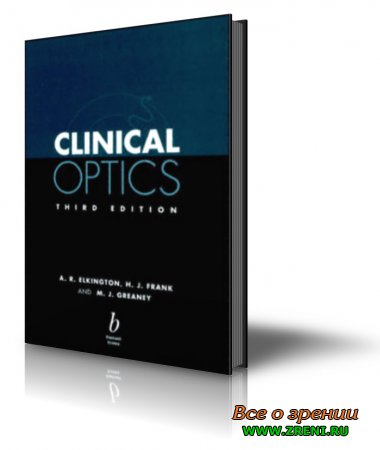Clinical Optics | Andrew R. Elkington
Автор: Andrew R. Elkington
Год: 2004
Формат: PDF
Качество: E-Book
Количество страниц: 296
Описание
In the preface to the second edition of this book we stressed that we had written the text in the hope of helping those trainee eye surgeons who were preparing to take their basic professional examinations.
We assumed that the optics they had learned at school had long since been forgotten, and we therefore set out to explain the subject from first principles.
Our aim was to keep the text logical and simple and we used diagrams liberally to complement the written word. These diagrams themselves were simplified so that they could be both easily memorised and reproduced – even under the stress of examination conditions.
Throughout the book we emphasised the clinical relevance of each topic and we hoped that this approach would allow readers to understand better the optical problems experienced by many of their patients.
During the eight years since that edition was published, many changes have taken place in the practice of ophthalmology. New methods of examination have become available, including sophisticated automated visual field analysers. There have been great advances in the design of intraocular lenses.
Corneal refractive surgery has become more popular and also more complex.
There are many new types of lasers in clinical use. All these advances depend upon the application of basic optical concepts in new settings.
In writing this third edition we have taken the opportunity to identify these principles and to explain their application in the context of modern ophthalmic practice. In so doing our aim remains the same, namely to enhance the care of patients by helping ophthalmologists to master the optical principles that underpin so much of their everyday work.
Contents
Preface to the Third Edition
Acknowledgements
Properties of Light and Visual Function
Reflection of Light
Refraction of Light
Prisms
Spherical Lenses
Astigmatic Lenses
Optical Prescriptions, Spectacle Lenses
Aberrations of Optical Systems Including the Eye
Refraction by the Eye
Optics of Ametropia
[banner_centerrs] {banner_centerrs} [/banner_centerrs]
Presbyopia
Contact Lenses
Optics of Low Vision Aids
Instruments
Lasers
Practical Clinical Refraction
Refractive Surgery Appendix 1
Appendix 2
Properties of Light and Visual Function
Light may be defined as energy to which the human eye is sensitive. Scientists do not yet fully understand the true nature of light in the physical sense, but the behaviour and properties of light have been extensively studied and are well known.
This book aims to describe with the aid of diagrams those aspects of optics which are relevant to the practising ophthalmologist. In this first chapter a simple account is given of the nature and properties of light.
Electromagnetic Spectrum:
Optical Radiation
Optical radiation lies between X-rays and microwaves in the electromagnetic spectrum (Fig. 1.1), and is subdivided into seven wavebands. Each of these seven wavebands group together wavelengths which elicit similar biological reactions. These seven domains are ultraviolet C (UV-C), 200–280 nm; ultraviolet B (UV-B), 280–315 nm; ultraviolet A (UV-A), 315–400 nm; visible radiation, 400– 780 nm; infrared A (IRA), 780–1400 nm; infrared B (IRB), 1400–3000 nm; and infrared C (IRC), 3000– 10000 nm. As with all electromagnetic radiation, the shorter the wavelength, the greater the energy of the individual quanta, or photons, of optical radiation.
The cornea and sclera of the eye absorb essentially all the incident optical radiation at very short wavelengths in the ultraviolet (UV-B and UV-C) and long wavelengths in the infrared (IR-B and IR-C).
The incident UV-A is strongly absorbed by the crystalline lens while wavelengths in the range 400– 1400 nm (visible light and near infrared), pass through the ocular media to fall on the retina. The visible wavelengths stimulate the retinal photoreceptors giving the sensation of light while the near infrared may give rise to thermal effects. Because the refractive surfaces of the eye focus the incident infrared radiation on the retina, it can cause retinal damage, e.g. eclipse burns.
Colour Vision
The visible wavelengths of the electromagnetic spectrum are between 400 nm and 780 nm. The colour of any object is determined by the wavelengths emitted or reflected from the surface. White light is a mixture of wavelengths of the visible spectrum. Colour is perceived by three populations of cone photoreceptors in the retina which are sensitive to light of short (blue), middle (green), or long (red) wavelength (Fig. 1.2).
A congenital colour vision defect occurs if a cone pigment is absent or if there is a shift in its spectral sensitivity. Hence, deuteranopia, protanopia and tritanopia indicate absence of green, red and blue cone function, and deuteranomaly, protanomaly and tritanomaly indicate a shift in the corresponding cone sensitivity. The X-chromosome carries genes encoding for red and green pigment whereas chromosome 7 carries the blue pigment gene. Of men 8% and of women 0.5% have a defect of the red/green system; the commonest is deuteranomaly which occurs in 5% of men and 0.3% of women. Tritan defects are rare.
Congenital colour defects characteristically affect particular parts of the colour spectrum. Acquired colour defects occur throughout the spectrum but may be more pronounced in some regions. For example, acquired optic nerve disease tends to cause red–green defects. An exception occurs in glaucoma and in autosomal dominant optic neuropathy which initially cause a predominantly blue– yellow deficit; it has recently been found that visual field loss in glaucoma is detected earlier if perimetry is performed using a blue light stimulus on a yellow background. Acquired retinal disease tends to cause blue–yellow defects (except in cone dystrophy and Stargardt's disease, which cause a predominantly red–green defect).
Купить или скачать книгу
Все файлы на сайте, прежде чем выкладываются, проверяются на вирусы. Поэтому мы даем 100% гарантию чистоты файлов.





Комментариев 0